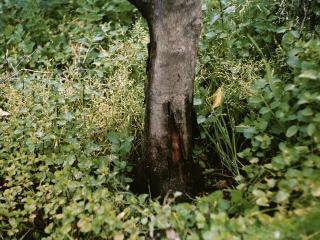Collar rot
Collar rot is caused by the fungal pathogen Phytophthora citrophthora, which thrives in damp conditions where organic matter on the soil surface is allowed to contact the trunk.
The first symptoms are patches of gum oozing out from the bark around the base of the trunk. The affected bark becomes wet and soft. If it dries out, splitting can then occur. If the organic matter is not cleared from around the base of the trunk the rot will continue to spread until the tree is ringbarked.
To prevent collar rot improve the air circulation near the trunk by keeping it clear of organic matter. Avoid wetting the trunk when watering, and improve soil drainage around the dripzone of the tree. Avoid injuries to the lower trunk and ensure the bud union is well above soil level.
Registered copper fungicides can be applied in autumn as a skirt or under-tree spray. The chemical phosphorous acid applied as a foliar spray will provide protection from Phytophthora infection.
Affected trees should have the lesions cut away into healthy tissue with a sterilised sharp knife. Resterilise the blade with methylated spirits between cuts, before treating the wood under the cuts with a copper fungicide.
Phytophthora root rot
Phytophthora root rot in citrus is caused by the pathogenic fungi P. citrophthora and/or P. nicotianae. Below-ground symptoms are the loss of feeder roots. Above-ground symptoms are a loss of vigour and spindly growth.
As the disease progresses the foliage turns yellow and twigs die back. Phytophthora root rot usually starts at the deeper roots, since these are more likely to be wet, and the fungus is more active in wet conditions. Trees may become more dependent on surface roots, and are therefore more sensitive to drying out.
To prevent the disease consult your local nursery for resistant rootstocks. Ensure that the bud union is 20cm above soil level so the susceptible variety above the graft union does not grow roots.
Water moderately as excessive soil moisture and poor drainage are a major cause of problems. Always use plant material from reputable sources.

